Image in Doc keeps shifting to the left
I just tested this on an XL object in a word document and I think it does what you want.
Select the object at the border then:
Right Click > Format Object > tab: Layout > select: In line with Text
Now the object will behave like text - you can put it in a paragraph of its own and make the paragraph centre justified.
Hope this helps, otherwise - please let us know exactly how you imported the worksheet.
Cheers,
Select the object at the border then:
Right Click > Format Object > tab: Layout > select: In line with Text
Now the object will behave like text - you can put it in a paragraph of its own and make the paragraph centre justified.
Hope this helps, otherwise - please let us know exactly how you imported the worksheet.
Cheers,
The key to managing object placement is proper use of the Layout dialog. Access it by selecting an object (table, picture, shape, text box, etc.) and right-clicking to choose More layout options... (for a table, choose Table Properties, then use the Position sub-dialog).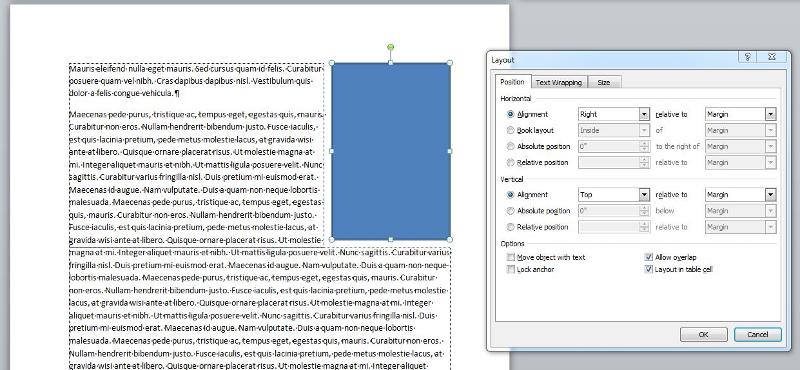 I set Layout preferences in the following order to manage how an object gets placed on a page.
I set Layout preferences in the following order to manage how an object gets placed on a page.
The Text Wrapping tab lets you define how text is to flow relative to the object. If you use In line with text, the object gets treated like a character, so if it is in its own paragraph, it will flow with the text. More useful layout styles include Square, Tight or Through to allow text to flow around the object. (For a rectangular spreadsheet, these styles will give much the same result.) Other wrap options allow you to place the object behind text (useful for placing a form behind text); in front of text (to be able to obscure text); or through (to allow a signature to appear to be writing over text for example).
The Size tab allows you to manage the height and width, as well as the rotation. If you lock the aspect ratio, an adjustment to either height or width will automatically adjust the other to maintain the original aspect ration.
The Position tab contains the most overlooked options for managing object behavior. If you want the object to flow with the text, leave the Move object with text checkbox turned on. However, with it turned off, the horizontal and vertical position settings will give you more control. For example, if you set the horizontal alignment to be Right relative to the Margin, and the vertical alignment to be Top relative to the Margin, the object will be set in the upper right no matter where the anchor point is within the page.
The book layout settings manage whether an object is placed on the inside or outside of pages in 2-sided print layouts (a fairly typical layout choice for placing pictures at the outer margins). The absolute positions give you very precise control, and can be useful for fitting an object to a form. The relative positions allow you to place an object at a given percentage relative to the selected reference point (for example, you could place a vertical line at exactly the center of a page by choosing 50% relative to the page).
The Text Wrapping tab lets you define how text is to flow relative to the object. If you use In line with text, the object gets treated like a character, so if it is in its own paragraph, it will flow with the text. More useful layout styles include Square, Tight or Through to allow text to flow around the object. (For a rectangular spreadsheet, these styles will give much the same result.) Other wrap options allow you to place the object behind text (useful for placing a form behind text); in front of text (to be able to obscure text); or through (to allow a signature to appear to be writing over text for example).
The Size tab allows you to manage the height and width, as well as the rotation. If you lock the aspect ratio, an adjustment to either height or width will automatically adjust the other to maintain the original aspect ration.
The Position tab contains the most overlooked options for managing object behavior. If you want the object to flow with the text, leave the Move object with text checkbox turned on. However, with it turned off, the horizontal and vertical position settings will give you more control. For example, if you set the horizontal alignment to be Right relative to the Margin, and the vertical alignment to be Top relative to the Margin, the object will be set in the upper right no matter where the anchor point is within the page.
The book layout settings manage whether an object is placed on the inside or outside of pages in 2-sided print layouts (a fairly typical layout choice for placing pictures at the outer margins). The absolute positions give you very precise control, and can be useful for fitting an object to a form. The relative positions allow you to place an object at a given percentage relative to the selected reference point (for example, you could place a vertical line at exactly the center of a page by choosing 50% relative to the page).
ASKER
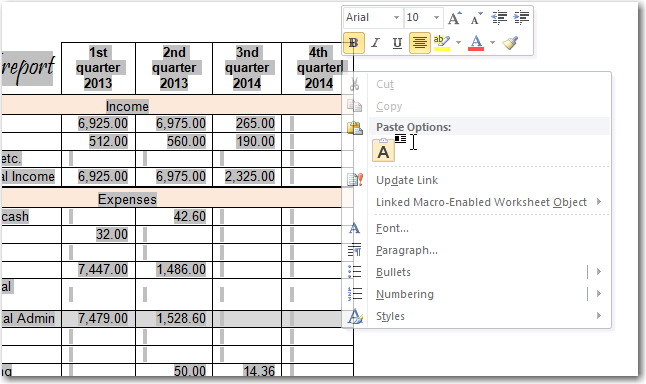
As you can see the options are not available, since this is an XL spreadsheet, not an image.
However, I think I've solved the problem. In checking your solution I discovered text behind the copy of the spreadsheet, and a second copy appeared lower down; haven't a clue where that got placed there, but I deleted the second copy and moved the text down, below the copy and now it seems to be behaving.
I will request this question be removed; as, it seems, I've answer my own question
ASKER
I've requested that this question be deleted for the following reason:
I've answer my own question and the responses were not relevant; having to do with objects.
I've answer my own question and the responses were not relevant; having to do with objects.
How is the pasted spreadsheet NOT an object Mike? I think you'll find that it is, and behaves exactly as I've described.
The default settings for objects being pasted into Word depend on some of the Word option settings, but the method you choose to paste the spreadsheet object into Word will determine what type of object it becomes, and what method you'll need to use to manage the wrapping. Review this Microsoft KB article for the various paste options available.
Your screen capture shows just one paste option. You will see other options if you turn on the "Show Paste Options button when content is pasted" checkbox within Word Options (File > Options > Advanced in the "Cut, copy, and paste" section). This screen shot shows the options and a live preview when I hovered over the "Link & Keep Source Formatting" option after I'd copied a part of an Excel sheet. The result for this option is linked to the sheet, so will change automatically if the Excel sheet is changed.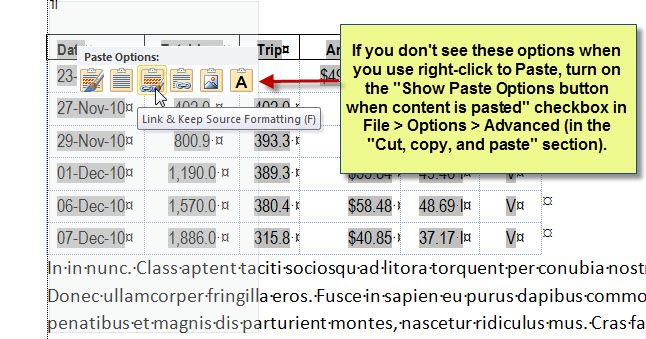 If I'd chosen the "Keep text only" option, the data would be pasted as if I'd typed it; if I'd chosen the "as picture" option, right-clicking on the pasted picture would allow me to use the Layout dialog as described.
If I'd chosen the "Keep text only" option, the data would be pasted as if I'd typed it; if I'd chosen the "as picture" option, right-clicking on the pasted picture would allow me to use the Layout dialog as described.
For the various Link options, the pasted object is treated as a table in Word, so you'll need to access the layout options from the Table Properties dialog as I'd indicated earlier. This screenshot shows the result.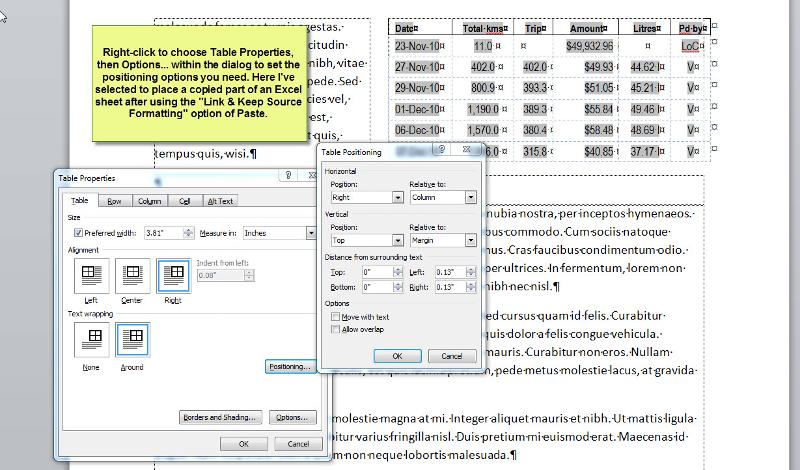 You need two steps: the first to paste; and a second to access the position options (by whatever method applies).
You need two steps: the first to paste; and a second to access the position options (by whatever method applies).
The default settings for objects being pasted into Word depend on some of the Word option settings, but the method you choose to paste the spreadsheet object into Word will determine what type of object it becomes, and what method you'll need to use to manage the wrapping. Review this Microsoft KB article for the various paste options available.
Your screen capture shows just one paste option. You will see other options if you turn on the "Show Paste Options button when content is pasted" checkbox within Word Options (File > Options > Advanced in the "Cut, copy, and paste" section). This screen shot shows the options and a live preview when I hovered over the "Link & Keep Source Formatting" option after I'd copied a part of an Excel sheet. The result for this option is linked to the sheet, so will change automatically if the Excel sheet is changed.
 If I'd chosen the "Keep text only" option, the data would be pasted as if I'd typed it; if I'd chosen the "as picture" option, right-clicking on the pasted picture would allow me to use the Layout dialog as described.
If I'd chosen the "Keep text only" option, the data would be pasted as if I'd typed it; if I'd chosen the "as picture" option, right-clicking on the pasted picture would allow me to use the Layout dialog as described.For the various Link options, the pasted object is treated as a table in Word, so you'll need to access the layout options from the Table Properties dialog as I'd indicated earlier. This screenshot shows the result.
 You need two steps: the first to paste; and a second to access the position options (by whatever method applies).
You need two steps: the first to paste; and a second to access the position options (by whatever method applies).
ASKER
This issue was not related to the Paste options; so I won't go there. The issue was with the movement of the Linked file, or "object", and the fact the when I right clicked on it; see attached screenshot, the positioning option didn't appear; so your suggestion was moot.
Since I found the solution; so didn't ask why the position option wasn't there, I don't believe your argument, against closing this question, has merit.
But I will defer to the Moderators; whatever they decide is fine with me. I don't want to nit pick.
Since I found the solution; so didn't ask why the position option wasn't there, I don't believe your argument, against closing this question, has merit.
But I will defer to the Moderators; whatever they decide is fine with me. I don't want to nit pick.
Well Mike, I believe your objection shows why it is sometimes important not to allow a question to be closed just because an OP thinks they have solved the problem.
I raised my objection because I do not think your question was solved at all. You copied content from a spreadsheet and when you pasted it, you had problems with how Word positioned it. It is a good question, and many people encounter the same problem.
Three of us have put in time and effort with suggestions about how you can use Layout options to solve your problem of the image shifting. Closing the question will eliminate the effort we've all made in addressing it. Moreover, closed questions are no longer available for other EE people to learn from.
DrTribos correctly identified the "copied worksheet" as an object, and made a good suggestion. Did you try it? He also asked for clarification about how you imported the spreadsheet, but you didn't respond.
My followup was based on knowing that Word provides layout options to manage how copied objects are positioned. I've been doing this in hundreds of documents for many years, but I also struggled with it, so know well that many other people are unclear about how it works.
Your screen snap does not show that the layout options are unavailable. Instead, it is a key factor in explaining the lack of layout controls because it shows that you didn't select the object correctly (per DrTribos' point). The following screen shots show why we can tell.
Right-clicking only displays context-sensitive options related to what is currently selected. Here is a capture of right-click options available when the focus was within a table object: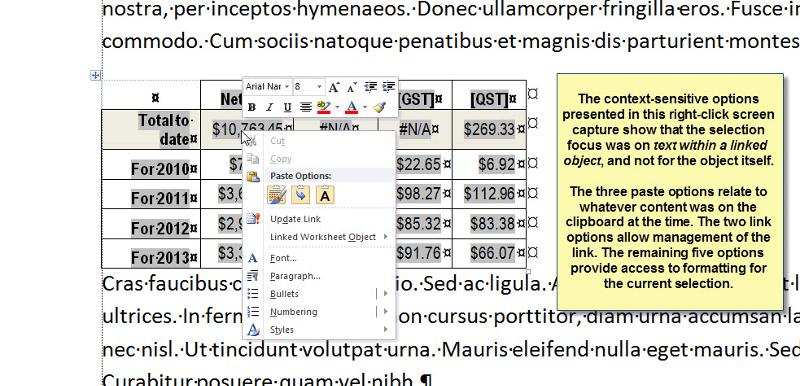 My Word options are set to show all available paste options (as noted earlier), so the paste options shown above merely reflect what was currently on my clipboard at the time. And in this case, I can see that my clipboard no longer contained the copied spreadsheet because the other paste options are not displayed (as they were for my screen capture shown earlier).
My Word options are set to show all available paste options (as noted earlier), so the paste options shown above merely reflect what was currently on my clipboard at the time. And in this case, I can see that my clipboard no longer contained the copied spreadsheet because the other paste options are not displayed (as they were for my screen capture shown earlier).
Compare that to this capture taken when the object was selected instead: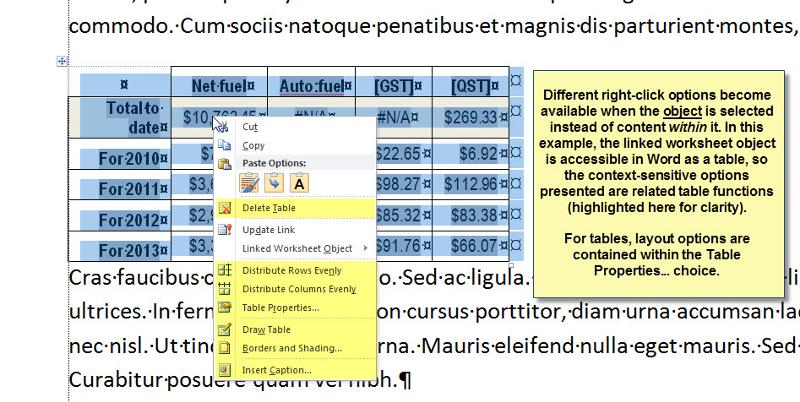 The same paste and link options are available, but now table-related options are offered instead of the formatting options. The layout settings you need to manage the placement are contained within a sub-dialog of the Table Properties... choice as indicated in my initial comment.
The same paste and link options are available, but now table-related options are offered instead of the formatting options. The layout settings you need to manage the placement are contained within a sub-dialog of the Table Properties... choice as indicated in my initial comment.
When the focus is within or on a table, a small 4-arrow blue icon is displayed in the upper left (as shown in both screen shots above). The full table was selected when I clicked the icon, as shown by the blue background in the 2nd capture. My Word options are set to always show field code shading, and since a field code manages linked spreadsheet objects, the grey shading in both captures gives me yet another clue about the object.
Word has many such settings to help provide feedback about what is going on as you use it. Users often miss cues that can be very helpful in debugging unexpected behaviour because some useful settings are turned off by default, and many others are quite subtle. Your question raised examples of both types, so I believe it is worth keeping in the EE knowledge base.
I raised my objection because I do not think your question was solved at all. You copied content from a spreadsheet and when you pasted it, you had problems with how Word positioned it. It is a good question, and many people encounter the same problem.
Three of us have put in time and effort with suggestions about how you can use Layout options to solve your problem of the image shifting. Closing the question will eliminate the effort we've all made in addressing it. Moreover, closed questions are no longer available for other EE people to learn from.
DrTribos correctly identified the "copied worksheet" as an object, and made a good suggestion. Did you try it? He also asked for clarification about how you imported the spreadsheet, but you didn't respond.
My followup was based on knowing that Word provides layout options to manage how copied objects are positioned. I've been doing this in hundreds of documents for many years, but I also struggled with it, so know well that many other people are unclear about how it works.
Your screen snap does not show that the layout options are unavailable. Instead, it is a key factor in explaining the lack of layout controls because it shows that you didn't select the object correctly (per DrTribos' point). The following screen shots show why we can tell.
Right-clicking only displays context-sensitive options related to what is currently selected. Here is a capture of right-click options available when the focus was within a table object:
 My Word options are set to show all available paste options (as noted earlier), so the paste options shown above merely reflect what was currently on my clipboard at the time. And in this case, I can see that my clipboard no longer contained the copied spreadsheet because the other paste options are not displayed (as they were for my screen capture shown earlier).
My Word options are set to show all available paste options (as noted earlier), so the paste options shown above merely reflect what was currently on my clipboard at the time. And in this case, I can see that my clipboard no longer contained the copied spreadsheet because the other paste options are not displayed (as they were for my screen capture shown earlier).Compare that to this capture taken when the object was selected instead:
 The same paste and link options are available, but now table-related options are offered instead of the formatting options. The layout settings you need to manage the placement are contained within a sub-dialog of the Table Properties... choice as indicated in my initial comment.
The same paste and link options are available, but now table-related options are offered instead of the formatting options. The layout settings you need to manage the placement are contained within a sub-dialog of the Table Properties... choice as indicated in my initial comment.When the focus is within or on a table, a small 4-arrow blue icon is displayed in the upper left (as shown in both screen shots above). The full table was selected when I clicked the icon, as shown by the blue background in the 2nd capture. My Word options are set to always show field code shading, and since a field code manages linked spreadsheet objects, the grey shading in both captures gives me yet another clue about the object.
Word has many such settings to help provide feedback about what is going on as you use it. Users often miss cues that can be very helpful in debugging unexpected behaviour because some useful settings are turned off by default, and many others are quite subtle. Your question raised examples of both types, so I believe it is worth keeping in the EE knowledge base.
Hi Eric - thank you for acknowledging my commen, I really do appreciate it.
Hi Mike - I really do have to agree with Eric on this one.
Kind regards, Steve
Hi Mike - I really do have to agree with Eric on this one.
Kind regards, Steve
This was your question:
"How do I anchor the worksheet I copied to my Word Doc?"
This was my answer:
"...right-click and select Format..."
If this was not correct, then you can ignore my post. If you changed the question, then you should open a new one. If you discovered that your question was invalid for your situation, there is still some value in the questions if it was correct.
How much did the points for this question cost you? If you need them refunded, then this could be closed with 0 points awarded, although typically if you question was answered correctly (even if you inadvertently asked the wrong question) then points should still be awarded.
"How do I anchor the worksheet I copied to my Word Doc?"
This was my answer:
"...right-click and select Format..."
If this was not correct, then you can ignore my post. If you changed the question, then you should open a new one. If you discovered that your question was invalid for your situation, there is still some value in the questions if it was correct.
How much did the points for this question cost you? If you need them refunded, then this could be closed with 0 points awarded, although typically if you question was answered correctly (even if you inadvertently asked the wrong question) then points should still be awarded.
ASKER
How is the pasted spreadsheet NOT an object Mike? I think you'll find that it is, and behaves exactly as I've described.
What I said was; “this is an XL spreadsheet, not an image.
Your screen capture shows just one paste option.
I see 6; with my cursor is on the “Link & Keep…” option. Eric’s post included that screen shot with a note that said; “If you don’t see these…” My screen shot shows that I did; and it shows which one I was clicking on.
I confess to not picking up on the Microsoft link article; but I have since and found that it clarified what I’d thought I understood about them.
I think my thoughts on deleting the question came when I felt I’d found the solution, and didn’t want to pursue the question I had about the “Layout dialog”; which as my screen shot demonstrates that it did not appear when I right clicked the Object I’d pasted; as DrTribos’ instruction said it would.
DrTribos asked -
please let us know exactly how you imported the worksheet.Which I thought was made obvious in my screen shot; so I didn’t respond to it.
Eric’s note explained how to access the “Layout Dialog” in the same way and since I didn’t get that option when I right clicked the object the rest of his note was of little consiquence.
This is why I said “this is an XL spreadsheet, not an image."
At this point I felt the question was answered and this “Layout dialog” issue was moot; and I didn’t want to spend any more time in a back and forth about how to find it.
At this point I am still not sure how that is done, since Eric’s screen shot shows the result, not the process.
Finally let me say I have taken the time to respond to your arguments; out of respect for what you do and the effort you put in and to demonstrate my respect for your effort. I truly appreciate your effort and don't, in any way, mean to cheat you of your due.
My response is not an effort to win an argument, but to help you see why I made this decision.
If the moderator feels inclined to favor your position I am fine with that; there will be no hard feelings on my part.
At this point I am still not sure how that is done, since Eric’s screen shot shows the result, not the process.When you select an object — whether it is an image or a pasted spreadsheet — layout options will be available. I cannot know what type of object you were dealing with, because it would depend on which paste option you'd used — and visually, several could look identical. For example, results from Keep Source Formatting, Link And Keep Source Formatting and Picture should be indistinguishable, yet the selection methods for each will be quite different.
The process is easy: use the appropriate selection method for the object, then choose the applicable context-sensitive option to access the layout controls.
A picture of a spreadsheet is the most straightforward because a right-click anywhere on it will work.
However, getting the correct context in a spreadsheet inserted with some of the other paste options can be more challenging: the Table Properties... choice is displayed if you right-click on content within a spreadsheet object inserted with Keep Source Formatting — but not if it had been inserted with the Link And Keep Source Formatting paste option. For that, you will only see the Table Properties if the entire table is selected.
I described the method I prefer of clicking the table indicator icon to select a table, and use it as my normal method to avoid these differences. You could also select a whole table by using the table menu, clicking within it and pressing Alt-5 (using the keyboard 5 with NumLock off), or using point and drag. However you do it, once selected, a right-click will then include Table Properties within the context-sensitive flyout.
Thanks for sticking with this Mike. I'm sure none of us intend to be confrontational, and we can all benefit from "exchange between experts".
ASKER
I'm still at a loss here.
Starting from scratch; I opened my spreadsheet and copied the worksheet (Ctrl-C)
Then I open a blank word doc and pasted the worksheet; with the Link & Keep source option.
This is apparently where I am supposed to use the layout option to lock it into place where I want it; when I rt click on the object; but...
You say is "simple" but when you start talking about table properties, table indicator icons, etc., my head spins; which is why I didn't really want to pursue this issue; and leave well enough alone. Now I'm caught up in resolving this question; and now so are you (-:
Overlays-with-notes.jpg
Starting from scratch; I opened my spreadsheet and copied the worksheet (Ctrl-C)
Then I open a blank word doc and pasted the worksheet; with the Link & Keep source option.
This is apparently where I am supposed to use the layout option to lock it into place where I want it; when I rt click on the object; but...
You say is "simple" but when you start talking about table properties, table indicator icons, etc., my head spins; which is why I didn't really want to pursue this issue; and leave well enough alone. Now I'm caught up in resolving this question; and now so are you (-:
Overlays-with-notes.jpg
ASKER CERTIFIED SOLUTION
membership
This solution is only available to members.
To access this solution, you must be a member of Experts Exchange.
[OFF TOPIC COMMENTS REMOVED]
But if this were my question, I would apply points as follows:
* 50 pts to post #1, rspahitzPosted on 2014-02-23 at 11:13:11ID: 39880981, because it addressed formatting first
* remaining pts to post #3, EricFletcherPosted on 2014-02-24 at 08:12:53ID: 39882881, because it was pretty thorough
But if this were my question, I would apply points as follows:
* 50 pts to post #1, rspahitzPosted on 2014-02-23 at 11:13:11ID: 39880981, because it addressed formatting first
* remaining pts to post #3, EricFletcherPosted on 2014-02-24 at 08:12:53ID: 39882881, because it was pretty thorough
ASKER
I haven't forgotten this question; I just haven't had time to give these responses the time, and respect, they deserve. I hope to get to it before the end of the week-end.
ASKER
This turned out to be the best, all in one place answer; that made me see why I failed to get it for so long. Good job; thanks for all your hard work and sticktoitivness.
You're welcome Mike -- and well done.
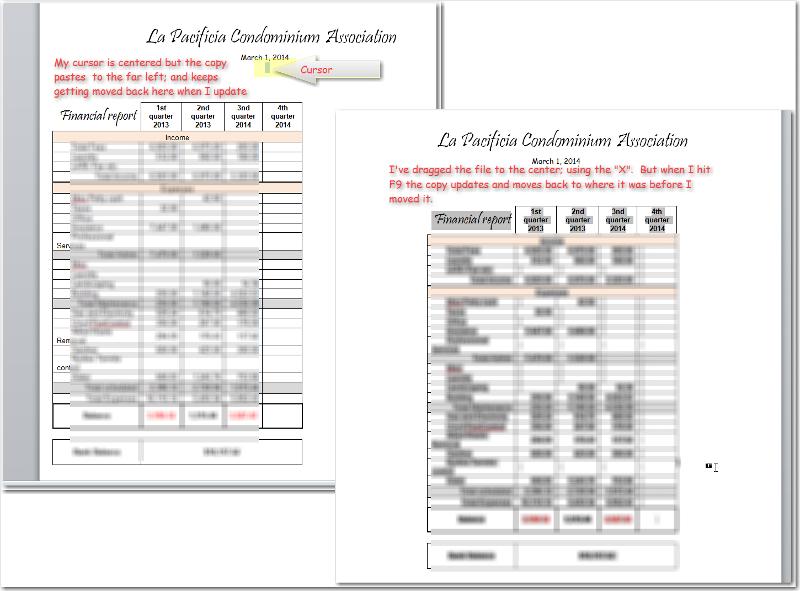
I've never tried it with embedded spreadsheets but with images you can right-click and select Format Picture then go to the Layout tab and pick an embedding style (inline, fixed location, etc.)